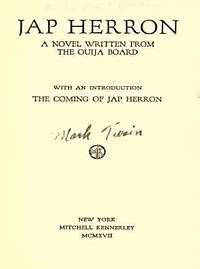Jap Herron
 | |
| Author | Emily Grant Hutchings, Lola V. Hays |
|---|---|
| Country | United States |
| Language | English |
| Genre | American fiction |
| Publisher | Mitchell Kennerley |
Publication date | 1917 |
| Pages | 245 |
| Text | Jap Herron at Wikisource |
Jap Herron: A Novel Written From The Ouija Board was a novel first published in 1917 claimed to be authored by Mark Twain seven years after his death. The book was transcribed by Emily Grant Hutchings who claimed to have had the novel dictated to her from beyond the grave by the deceased Mark Twain through use of a Ouija board.
History
The novel first rose to fame when The New York Times ran a review of the book on September 9, 1917.[1] The work was claimed to be authored by the spirit of late Mark Twain by two mediums, Emily Grant Hutchings[2] and Lola V. Hays with Hays being the passive recipient whose hands guided the Ouija board.[1] Previously Hutchings tried to contact Patience Worth.[1][2] The two mediums claimed to have started transcribing the novel in 1915 and to have taken 2 years to complete. Due to the popularity of Ouija boards at the time, many Americans purchased the book and accepted Hutchings' claims at face value.
Copyright lawsuit
In an attempt to stop Hutchings from profiting from the Mark Twain's name, Clara Clemens filed a lawsuit in the Supreme Court against Hutchings and her publisher Mitchell Kennerley on June 8 1918.[3][4] Because Clemens and her publishers were unable to disprove that the book was not written by the ghost of Twain, a lawsuit filed to either have Hutchings admit the book is a fraud or surrender all profits to the Mark Twain estate and Harper & Brothers who at the time had sole rights to the Mark Twain stories.[3][5] While Hutchings never retracted her claims, the lawsuit was eventually dropped when Hutchings agreed to destroy all existing copies and cease publication.
References
- 1 2 3 "LATEST WORKS OF FICTION JAP HERRON". The New York Times. September 9, 1917. Retrieved 18 August 2017.
- 1 2 "EMILY: 'That Hannibal Girl'". Retrieved 18 August 2017.
- 1 2 "SUE FOR "SPIRIT" STORY". The New York Times. June 9, 1918. Retrieved 18 August 2017.
- ↑ "TWAIN'S DAUGHTER SPURNS SPIRIT BOOK". The New York Times. February 11, 1918. Retrieved 18 August 2017.
- ↑ Higgins, Parker. "How Mark Twain's ghost almost set off the copyright battle of the century". Splinter. Retrieved 18 August 2017.
External links
- Jap Herron : a novel written from the Ouija board Internet Archive
- Google Books copy